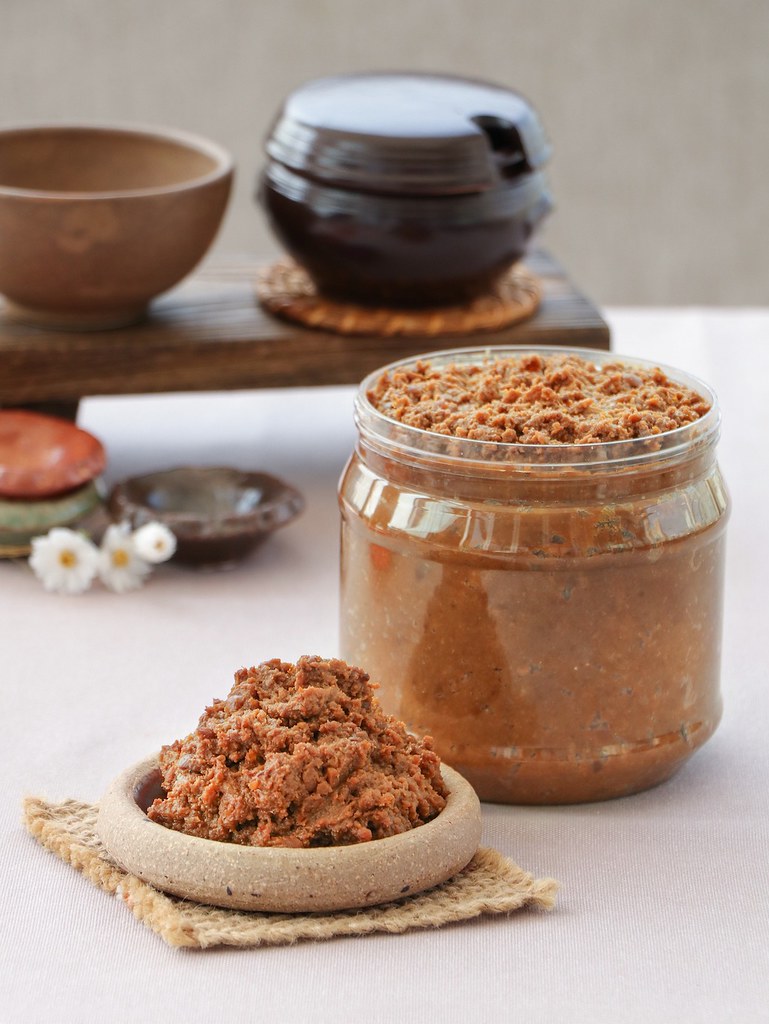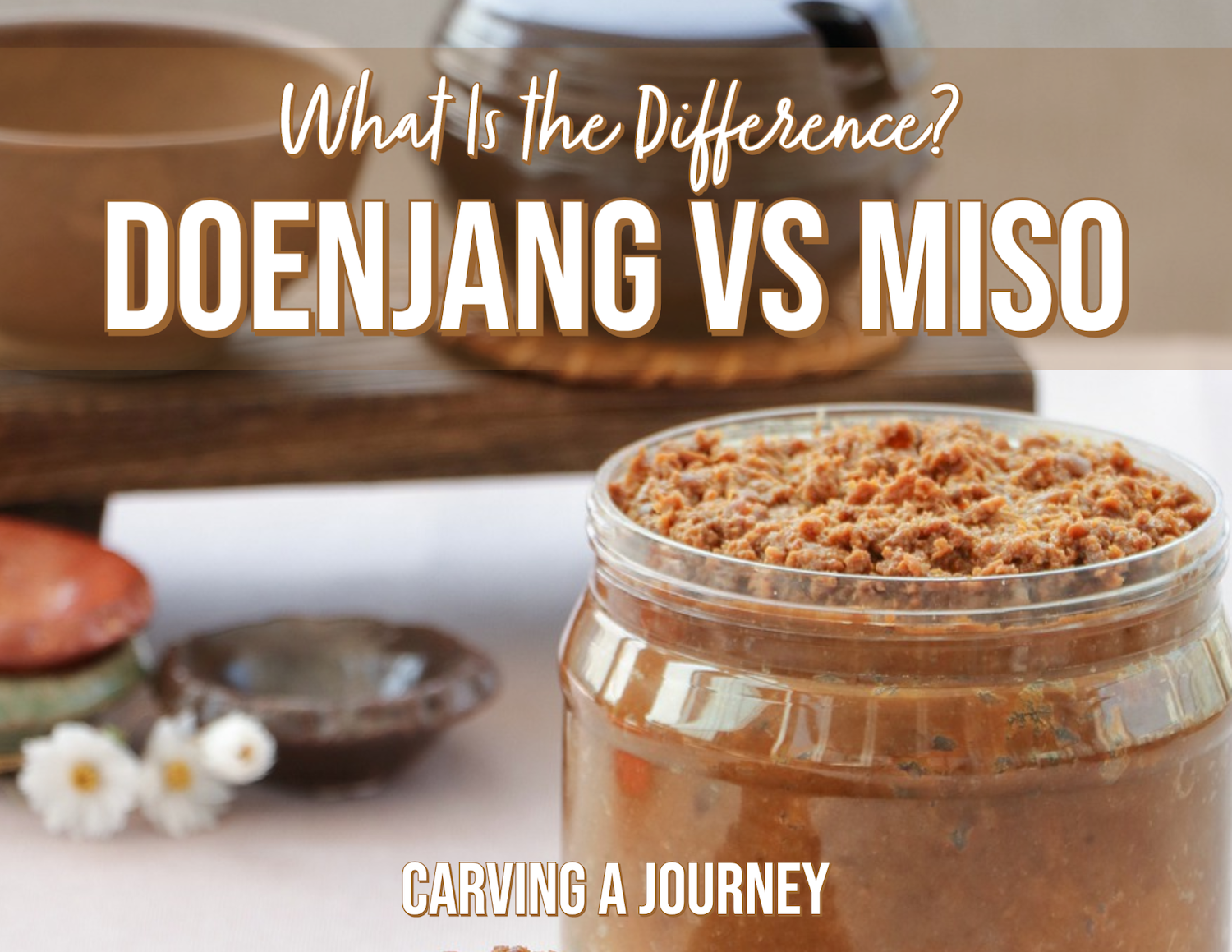This post may contain affiliate links. Please read my for disclosure details at the bottom of this post. As an Amazon Associate, I earn from qualifying purchases on this post about doenjang vs miso.
In both South Korean and Japanese cultures, they have a condiment made from soybeans. On one hand, in South Korea, they have doenjang. On the other hand, in Japan, they have miso. While both products are made from soybeans, are fermented, and are used in cooking, they are incredibly different. Here, we will explore the difference between the two! So, doenjang vs miso: what is the difference?
What Is Doenjang Paste?
Doenjang, known as soybean paste in English, is a type of fermented paste used in Korean cooking made from soybean and brine. In Korean eating culture, they use doenjang in many different ways. For example, doenjang can be mixed with other ingredients to be eaten as a condiment A popular mixed condiment is ssamjang, a dipping sauce served with Korean barbecue. Doenjang can also be used as the base in soups and stews, as well as a sauce for braising fish and meat.
How to Make Doenjang (Doenjang Production Process):
The earliest records of soybean fermentation in Korea dates back to a time before the Three Kingdoms era. Known documents and writings about doenjang go back as far as the 3rd century A.D.
In Korea, people make soy sauce and doenjang during the same process. Actually, doenjang is the byproduct of making traditional Korean-style sauce sauce! To make doenjang, you start by making ‘meju,’ a soybean brick. First, the soybeans are soaked overnight. Then, they are boiled in saltwater before finally being pounded in a mortar or millstone. These pounded soybeans are then shaped into the meju soybean bricks and left to dry.

A Row of Meju Bricks Drying.
Once washed and dried, the meju bricks are placed in onggi crocks (jangdok). Then, brine and further ingredients are added to the crocks as well. After some time, once the brine and meju bricks have aged and fermented, the brinks are broken down into chunks to become doenjang. The brine is then boiled to become Korean-style soy sauce.
So, with this style of fermentation, Koreans make two products they use in everyday cooking!

Once the Meju Dries, People in Korea Place Them in Jars.
Doenjang Ingredients:
While the most traditional Korean doenjang uses only a few ingredients, the commercial and heavily processed versions use a lot of additives.
Traditional Ingredients May Include:
- Soybeans
- Water
- Sea Salt
- Dried Chili Peppers; And
- Dried Jujubes
Commercial Ingredients May Include:
- Soybeans
- Water
- Salt
- Alcohol
- Koji Starter; And
- Wheat
If you want to buy commercially made doenjang, but are on a gluten-free diet, I recommend checking out our blog post for ‘Gluten-Free Doenjang Brands.’ There, we have lots of recommendations. You can find some of these recommendations below in my Amazon picks!
Unfortunately, there isn’t a soy-free substitute for doenjang at this time.
Doenjang Flavor (What Does Doenjang Taste Like?):
If you place doenjang on a spoon and take a bite, you will automatically taste salt. If you are unfamiliar with doenjang, you may not be able to detect any other flavor by itself. Doenjang really shines when combined with other ingredients and flavors. Once combined with other ingredients (such as with water as a soup base), you will find that doenjang tastes rich, savory, and earthy.

A Jar of Doenjang.
Honestly, there isn’t a comparable flavor in the Western culture. Finally, though also made from soybeans, Japanese miso does not taste anything remotely like doenjang. So, now that we have learned about doenjang, let’s learn the history, taste, and uses of Japanese miso!
What Is Miso Paste?
Miso is a traditional Japanese paste made from fermented soybeans. The paste is used for sauces and spreads, as well as for pickling vegetables, braising fish and meat, and as a base in soups and stews.
How to Make Miso (Miso Production Process):
Like doenjang, miso is made through fermentation. Though that is the case, the process of fermentation is quite different. To make miso, you go through a two-step process. The first step is making koji, a type of fermentation starter culture made using a grain such as rice, barley, and/or rye. Traditionally, to make koji, you must introduce the mold ‘Aspergillus oryzae’ onto your grain. The mold ferments creating the starter for the miso. Then, you complete the second step– add the koji to the soybeans and other ingredients to ferment and age. Letting everything ferment turns the soybeans into miso!
The type of miso produced depends on the koji starter, the treatment of the soybeans, and the further ingredients.

A Bowl of Soybeans!
Miso Ingredients:
Miso can have a variety of different ingredients! These ingredients help define the type of miso being produced. The production of miso can include:
- Barley
- Whole Wheat
- Brown Rice
- Chili Peppers
- Hemp Seed
- Buckwheat
- Highland Barley
- Millet
- Soybeans; And So On…
While doenjang keeps the same basic ingredients, the ingredients of miso changes depending on the type of miso desired. To learn all about the different types of miso, I recommend checking Nami’s blog Just One Cookbook! She has an in-depth article on the subject.
Many types of miso can be free of certain major allergens such as gluten. I enjoy and recommend buying the Hikari Organic Miso paste. They sell different types of gluten-free miso. You can find recommendations below in my Amazon picks!
Unfortunately, like doenjang, miso is a soy-based product and does not have a good substitute at this time.
Miso Flavor (What Does Miso Taste Like?):
Like I stated above, the flavor of miso is dependent on the koji starter, the treatment of the soybeans, and the further ingredients. While some miso pastes taste incredibly sweet, others have a bolder and richer taste.
You can have miso that tastes sweet, fruity, earthy, savory, and so on… Just know, miso will always have a strong taste of saltiness from the aging, preserving, and fermentation process!

A Bowl of Miso-Based Ramen!
In Summary, Doenjang vs Miso: What Is The Difference?
- Origin: On one hand, doenjang is a Korean invention made from soybeans. On the other hand, miso is a Japanese condiment made from soybeans.
- Ingredients: The most traditional and basic ingredients for Korean doenjang include salt, water, and soybeans. Japanese miso can potentially contain many different types of ingredients depending on the variety of miso!
- Production Method: While Korean doenjang is made from fermenting bricks of dried and aged soybeans, Japanese miso is made from fermenting soybeans with a mold starter.
- Flavor: Korean doenjang always has a salty and earthy flavor that is bold and savory. On the other hand, Japanese miso has a variety of different flavors depending on the ingredients!
So, there you have it! Do you now know the answer to ‘doenjang vs miso: what is the difference?’
We Hope You Enjoyed Learning About Doenjang vs Miso!
We hope you enjoyed learning about doenjang vs miso! If so, let us know in the comment section below. Also, we would love to hear about your favorite Korean and Japanese recipes using these specialty ingredients!
If you would like to read more about cooking, you can find further articles like these, as well as recipes on our blog. We listed some of our favorite Carving A Journey articles and recipes below! For reference, many recipes are influenced by our blended Korean and Southern heritage.
Carving A Journey Comparison Articles:
- Kimbap vs Sushi: What Is the Difference?
- Tamari vs Soy Sauce: What Is the Difference?
- Moon Pie vs Choco Pie: What Is the Difference?
- Frittata vs Quiche: What Is the Difference?
Carving A Journey Food and Drink Recipes:
- Tteokkochi Recipe (Korean Rice Cake Skewers)
- Bibimmyeon (Spicy Korean Cold Noodles)
- Andong Jjimdak (Korean Braised Chicken)
- Korean Strawberry Milk Recipe
- Brown Sugar Iced Latte (Korean Burnt Sugar Latte); And
- Korean Banana Flavored Milk
If you have any questions or comments, you can also email us at [email protected].
And, finally, we would love to hear from you through our social media as well! You can follow us at @carvingajourney on Instagram, Twitter, Facebook, and Pinterest. Or, if you would like more articles like these, you can subscribe to our blog by joining our mailing list. We hope you enjoyed learning about the difference between Korean doenjang and Japanese miso! Thank you so much for stopping by!
Carving A Journey is a participant in the Amazon Services LLC Associates Program, an affiliate advertising program designed to provide a means for sites to earn advertising fees by advertising and linking to Amazon.com. Although we may earn commissions for our endorsement, recommendation, testimonial, and/or link to any products or services from this website, these opinions are my own and I fully support these products.

